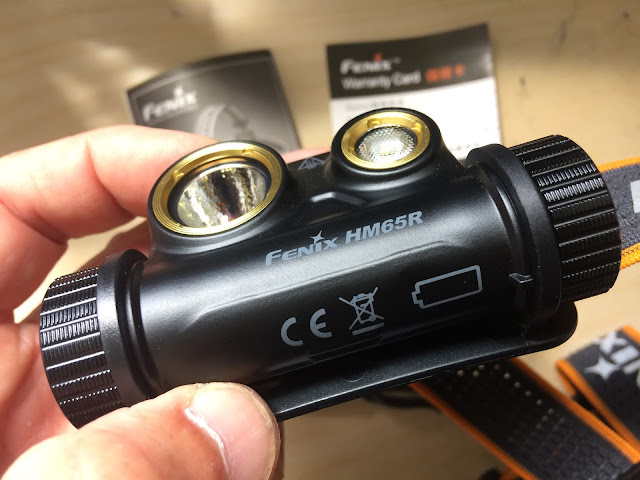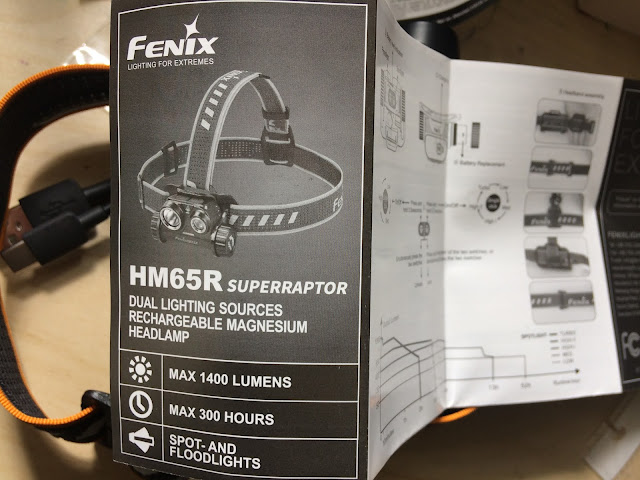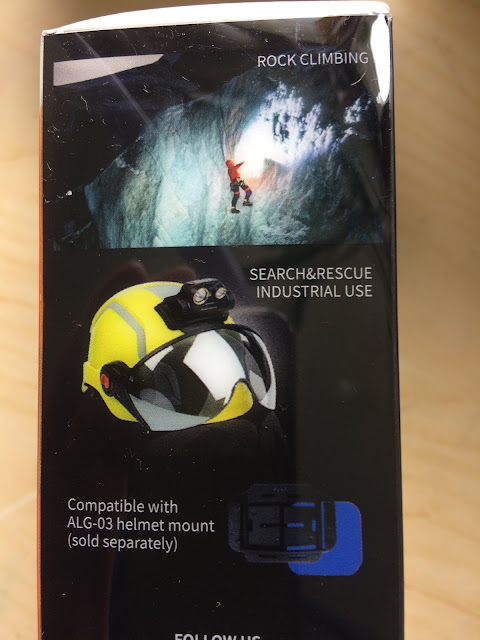FENIX SUPERRAPTOR HM65R Edition
New from Fenix, the SUPER RAPTOR a modified version of the HM65R. This model featuring an upgraded driver circuit and a change in color temperature of the LED's.
A 5 year warranty appeals to me along with a "Lock out" function to prevent accidental powering on of the lamp whilst in a pack or pocket. or any luggage for that matter.
Run times are battery dependent and mode dependent.
There are two CREE lamps, one with a lens to form a "Spotlight" beam and the other to form a "Flood light" beam.
The lenses are made from toughened glass.
The main body has been constructed from a magnesium alloy, which is lightweight but durable. The battery (18650 protected) of the Fenix Super Raptor can be charged in situ via a USB Type C connector (ie a thunderbolt type connector) which are much less prone to damage than the Type B micro USB plugs and also Type C is symmetrical, therefore there is zero chance of incorrect insertion due to an asymmetrical plug design.
It takes approximately 3 hours to charge a flat battery via the USB cable. One light on indicates: 21-40% charged; 2 lights on 41-60% charged; three lights on 61-80% charged and 4 lights on 81-100% charged. One light flashing, you're in trouble if you are still underground and no spare batteries LOL, but seriously, it means 0-20% charged! By pressing a combination of the switches (see manual), the approximate charge can be determined at any time.
Diagram on the casing indicates the correct insertion of the battery.
The unit is waterproof to 2 m for up to 30 minutes to satisfy the IP68 test requirement. The Super Raptor is supplied with a spare O-ring as well.
A full set of easily understandable (At least it was easy for me to understand) operator instructions in several languages was supplied along with a warranty card
The Fenix Super Raptor can be powered by 2 CR123A non rechargeable batteries and generic 18650's however, Fenix recommend the use of quality made protected 18650 batteries. There is no warranty against the incorrect use of any type of battery and or resulting damage from such use.
The light came with a 3500mAh 12.6watt 18650 battery.
The Fenix Super Raptor is indistinguishable from the previous model except for the model markings on the opposite end cap (non removable) to that of the battery. There it is marked as: "SUPERRAPTOR EDITION".
An O-ring sealed battery port provides an IP68 level of water resistance to 2m pressure for up to 30 minutes submersion.
During charging there is a LED indicator which enables the user to determine approximately the current charge capacity at any one point in time.
Construction materials:
Aluminium, polycarbonate and magnesium alloy, elastic and silicone material for the head band.
There is a small "plate" which partially covers the two switches to help prevent accidental switching. This is only in effect when the light is not in the tilted position.
I'm not going to write out or paraphrase the comprehensive operating instructions, suffice it to say I found them easy to read and understand and they are available in: Polish; German; Suomi; Chinese and English.
The Fenix Superraptor comes with a Type C USB cable, spare O-ring and Headband. Optional accessories are a special helmet mounting plate.
Why did I get this lamp?
I wanted it for caving and will test it thoroughly. To be honest it will comprise of a main light until I can get a hold of a more professional caving lamp (from WISDOM, who manufacture mining lights and are approved in this area with certifications such as MSHA, IECEX etc.)
Dual beams ( not a necessity for caving) but waterproofness to at least 2m is a definite must have for caving. Dual lights may provide some redundancy for LED failure or more likely switch failure, as it is a mechanical switch system.
In case you are wondering the Flood light is the smaller of the two lights. The casing gets slightly warm to the touch when charging from dead flat (totally normal). As for operating temperature, this I will determine during the real field test of some caving of course in the coming months where we will be entering some large systems in the Northern hemisphere ( not that we don't have any big systems in Australia LOL!
What's the difference between this Superraptor and the previous model? Well the previous model did not have a constant current drain and as such the Lamps were said to dim over their published working times, hence a different driver circuitry. The colour temperature of the LED's is also said to differ. As to these claims I can only report what I have read so far on the internet both officially and unofficially as I don't own the previous model.
Finally, can the light be powered on whilst charging is taking place?
During charging, the Medium power level of either the Flood light or the Spotlight can be selected. Once charging is complete, the light will not automatically power on.
No where is it recommended or suggested otherwise in any of the FENIX literature that the SuperRaptor is suitable for caving purposes. For me this seems strange but there may be a reason?
Supposedly it is 97 hours duration at 30 lumens in spotlight mode. This, I'd have to see as I don't believe that! 30 lumens is more than enough light for caving unless one want to light ginormous caverns and or highlight particular speleothems some distance away from the viewers or highlight a tricky manoeuvre for safety. If one is not bivouacking underground, then 20-24 hours of caving in a sports type cave is a long time, so this would be like 4 trips underground before a recharge. The literature also states that longer runtimes are possible with bigger capacity batteries. The supplied battery is rated at 3500mAh 12.6 watts.
It should be noted that when ALL FOUR LEDs are lit on the power switch, this DOES NOT mean fully charged cell, it merely indicates a cell which has a charge anywhere between 85-100% capacity.
Time will tell as to the overall durability of this light for the demanding use during caving.
Availability:
Currently NOT available in the USA.
and many pictures show different body markings
for example: where the words SuperRaptor appear on the main torch body unlike my model where the markings are on one of the end caps.
BCT
Latest News!!
Check the first caving review here of the Fenix Super Raptor
HM 65R

























